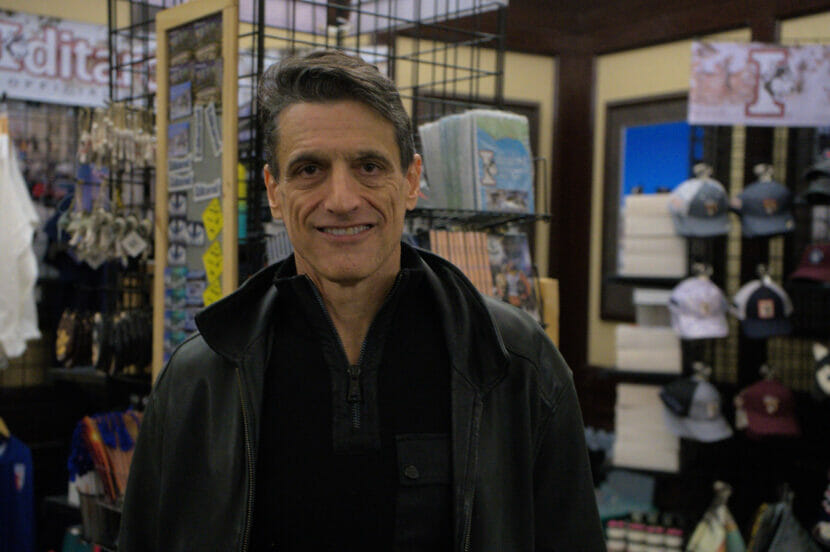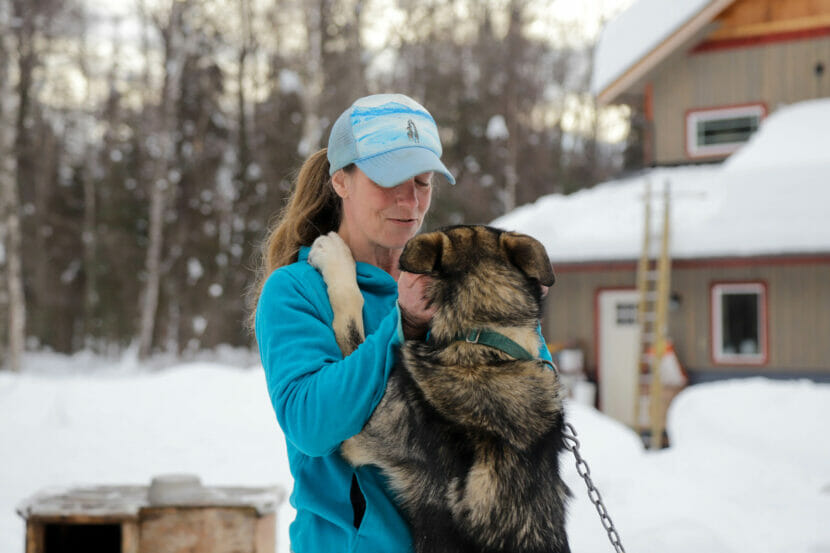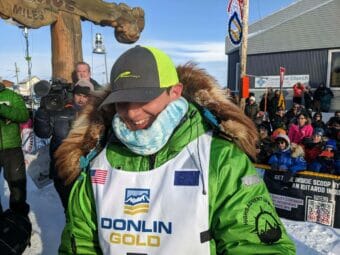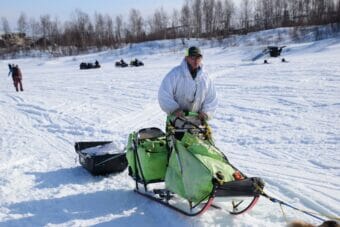
Outside at his kennel in Knik, shortly before the start of the Iditarod Trail Sled Dog Race, musher Jason Mackey was contemplating how to replenish his dwindling supply of meat, fish and kibble to feed his dogs.
His freezer had just a few more Yukon River fish, donated from a friend. Nearby in the snow, he had stashed a small pile of frozen whole king salmon salvaged from researchers on the Gulkana River next to some boxes of animal-feed grade beef blocks labeled “inedible.”
His kibble was almost gone, and a trip to the store would cost him.
“In 2004, when I ran my first Iditarod, we paid $28 a bag for the Red Paw kibble that we feed today,” he said. “Today, that bag of dog food is $68.”
Mackey is just one of many mushers in this year’s Iditarod field struggling with the rising costs of dog mushing, driven by disproportionate inflation on dog food and other supplies. Many mushers cite financial pressure as their biggest concern about continuing to compete in the Iditarod. With just 33 mushers, this year’s Iditarod already has the fewest number of teams in the race’s 50-year history. It’s far below the average, 63. At one point, in 2008, 96 teams signed up.
Iditarod CEO Rob Urbach called the low sign-up this year a “wake-up call” but said it’s no reason to panic.
“We don’t really think it’s necessarily a trend going forward,” he said.
Urbach said the low sign-up is partly driven by just coincidence in timing, as some mushers sit out because of injuries, retirement and mid-career breaks.
That group includes five-time champion Dallas Seavey, 2018 winner Joar Leifseth Ulsom and longtime musher Aaron Burmeister. All three are sitting out this year to spend time with family. There’s also an older generation of mushers who have signaled they’re retiring or phasing out of the sport in recent years, like four-time winners Jeff King and Martin Buser, and fan-favorite Aliy Zirkle.

Still, while Urbach said he’s not panicked about this year’s record-low turnout, the Iditarod race organization is looking at ways to attract more teams and encourage the next generation of mushers. He said competing in the 1,000-mile race requires five to 10 years of preparation for most people.
Urbach said the organization plans to loop the Junior Iditarod into the Iditarod. The junior, 150-mile race is for mushers ages 14 to 17 and it’s now run as a separate event. But, Urbach said, if both races are held at the same time, young mushers could overlap with Iditarod teams, and meet the teams at one of the first checkpoints. He said the Iditarod has also been exploring hosting a shorter, mid-distance qualifying event during the Iditarod and looking to see if it can help mushers save costs on dog food by organizing food buying co-ops.
Some mushers hope the Iditarod organization can do more to support aspiring mushers. Several pointed to prize money as an incentive for kennels to race. The total prize amount split by Iditarod finishers topped out at more than $900,000 in 2008, and in the ensuing years shrunk to $500,000 — where it has remained the past few years, even as inflation crept up.
“It’s no secret that the Iditarod has a $4 million budget,” said Mitch Seavey, a three-time Iditarod champion who is skipping this year’s race to let his body recover. “It makes me wonder why the purse isn’t bigger and why the mushers aren’t being supported.”
Seavey wants the Iditarod to host more races throughout the year to keep enthusiasm high for the sport. The Iditarod’s $500,000 purse is the largest of any major long-distance sled dog race in the world. The Kuskokwim 300, the race with the second-biggest purse in Alaska, pays out about $160,000 in prize money to a field of 25 teams. The Yukon Quest Alaska paid out $100,000 to its eight finishers.
Jessie Holmes, who placed third in last year’s Iditarod, said having big prize purses is a big factor in how he selects the races he’ll compete in.
“It gives more opportunity for a professional musher to go out and race for purse money which is huge,” he said.
Still, some mid-distance races have been thriving in recent years, despite modest prize money. The Willow 300 attracted 24 teams even with its modest $18,000 purse.
Joe Taylor, a 30-year-old who keeps a 13-dog kennel outside of Fairbanks, said he might not ever race the Iditarod again after his rookie year in 2022.
He said mid-distance races are more attractive for people his age who don’t want to dedicate their entire lives to dog mushing.
“They’re a lot more achievable for smaller kennels and also people want to be able to do other things with their lives during the winter and have a more balanced social life,” he said.

Urbach said the Iditarod hopes to boost the prize purse, but it hasn’t been easy. For one, the race organization’s costs have risen about 30% in the past 18 months, digging into the race’s budget, he said. It’s working to raise more funds through individual donations and its Iditarod Insider media platform, plus a handful of other new online initiatives.
Urbach also said finding major corporate sponsors has gotten harder in the past few years, too, something he attributes to pressure from animal rights groups like People for the Ethical Treatment of Animals, or PETA, which opposes the Iditarod because it believes dog mushing amounts to animal cruelty.
“It’s a big, big challenge for us,” he said at a town hall meeting in December. “Our extremist friends have made it pretty difficult for Lower 48-based public companies to sponsor us.”
Corporate sponsors that have pulled out of the race in the past decade include ExxonMobil, Alaska Airlines and Anchorage Chrysler Dodge Jeep Ram. Fiat Chrysler Automobiles, the parent company of the local dealership, was targeted with more than a quarter-million emails from PETA supporters, PETA said at the time. PETA also took out full-page ads in the Anchorage Daily News and paid for radio ads this year, according to a news release from the organization.
Urbach said aside from growing its own initiatives, it’s also pushing the Alaska Legislature to step in and support sled dog racing, Alaska’s official state sport, by allocating money to the Iditarod.
“We bring direct revenue of around $20 million to the state during the race, but the indirect is much, much larger,” said Urbach.
Currently, he said, the state government doesn’t contribute to the race.
Even with the tough climate there are promising signs for the sport. Sign-ups for the Junior Iditarod this year were higher than they’ve been in more than a decade. New mushers are developing kennels and completing qualifying mid-distance races.
“I ran five mid-distance races this year and three of the five were full,” said Brent Sass, last year’s Iditarod winner. “And a lot of names I’ve never heard, which means there’s a lot of new folks coming up the road. I feel like there’s still a lot of potential with the sport.”

Anja Radano, who keeps a small kennel near Talkeetna, said she doesn’t race the Iditarod for the money, but she does need to save cash in order to compete.
She’s working two jobs to pay for her kennel upkeep. She competed last year and is skipping this year to save up again to race. She estimates racing the Iditarod costs her an extra $20,000 per year. She said she’s attracted to the smaller, shorter races, which don’t require the same dedication, but she said the 1,000-mile race still has its allure.
“Mushing is not a sport you’re ever gonna make money with,” she said. “I’m definitely not giving up on the Iditarod.”



